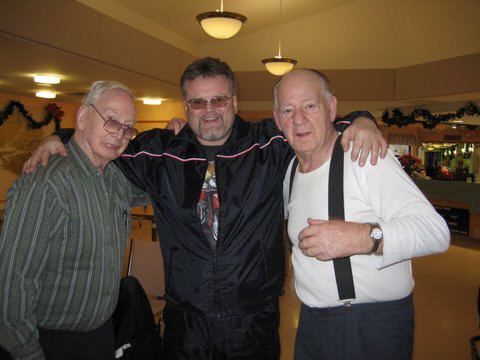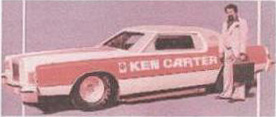Stunt World 1
www.stuntworld1.com
Those Magnificent Men & Their Flying Machines
Stunt drivers Jimmy Canton and Bumps Willert once toured the country performing death-defying feats with ordinary cars. And they lived to tell about it.
It's hard to believe, but there was a time when auto thrill shows drew larger crowds than NASCAR races. Spectators packed rickety wooden grandstands to watch daring young men in spiffy white uniforms do the "slide for life" or the "T-bone crash," to drive cars on two wheels, or to jump cars or motorcycles from ramp to ramp. In the late 1950s as many as 29 stunt shows - including Jack Kochman's Hell Drivers, Joie Chitwood's Tournament of Thrills, and Jimmy Lynch's Death Dodgers - toured, the country.
Last year there were only three. Live shows of flying, crashing, and spinning automobiles have been supplanted by TV programs like World's Greatest Police Chases, Car Crashes, and Stupid Driving. Today, only a few drivers know how to do a T-bone crash, crawl from the wreckage, and salute the crowd with a cocky smile and a jaunty wave.
One of Lucky Teter's Hell Drivers catches significant air in the late '4Os (above), and an unidentified member of Jimmy Lynch's Death Dodgers does likewise (below right).
Bumps Willert and Jimmy Canton are two of them.
Loren (Bumps) Willert joined Joie Chitwood's auto thrill show as a mechanic the day after he graduated from high school, in 1953. The next night, Willert did the slide for life, where the stunt man lowers himself off the back of a speeding car and slides on his posterior through a circle of flaming gasoline. "I'd only seen it once, the night before, when the original guy got hurt," says Willert. "Two days later I did the firewall stunt, where you drive a car through a burning wall, and two days after that I barrel-rolled my first car. I guess I was either real gullible or a quick learner."
Jimmy Kolstow was already a seasoned thrill show veteran when Willert joined Chitwood's show. Kolstow ran away from home to join Chitwood in 1951, and performed as "Jimmy Canton" so his parents wouldn't recognize his name on posters advertising the show. After 52 years as Jimmy Canton, that's the way he's listed in the phone book - "in case somebody from my thrill show days needs to find me."
Canton, like Willert, was recruited to do the slide for life after only one day on the job. "You had the leather pad you slid on, gloves, coveralls, and a helmet," he recalls. "You slid through the fire so fast you barely felt it. The trick was to keep your hands and legs up and just slide on your fanny till you stopped. Later on, it was a tradition that for the last show of the year, before we laid off for the winter, that the crew would hide the leather pad. They'd be generous and give you an extra pair of coveralls, and you'd do the slide that way, without the leather pad. That was the one time you'd want to roll instead of slide. As soon as you cleared the fire, you'd tuck your arms in tight and start rolling like a log. It's pretty amazing how far you can roll like that, and not really get much more than a few bruises. The coveralls were pretty much worn out, though."
Canton specialized in motorcycle stunts. His talent for jumping 30 or 40 feet in the air pales in comparison to today's flamboyant motocross jumping exhibitions - until you compare the equipment. "I usually jumped a 300-pound BSA 350 Scrambler with maybe three or four inches of suspension travel, and both the take-off and landing ramps were two feet wide," he says. "The other guys used to tease me that I was showing off twisting the handlebars and my body in the air, but I wasn't. I was manhandling the bike so I'd hit that narrow little landing ramp."
Canton's most memorable motorcycle crash came when he rode an imported Benelli motorcycle, marketed briefly in the United States by Montgomery Ward department stores. When he left the take-off ramp, the front forks separated and the front wheel fell off. He pole-vaulted over the handlebars when he landed. "I did a lot of serious rolling, until things finally stopped moving," says Canton. "I was laying there face down, taking mental inventory of body parts, thinking, Hey, I got away with it. . .and Bam! That damned Monkey Ward motorcycle landed on my back. No permanent damage, but I was sure sore for a couple days."
If there were a Hall of Fame for the Wall of Flame, Canton would surely be in it. Note the many scars on top of his helmet.
While Canton and Willert downplay their injuries, they acknowledge that their jobs humored few mistakes. Freak accidents were their greatest concern. "The first year I was with the show, Snooks Wentzel died doing a simple barrel roll," says Willert. "There was a fire in the engine compartment, just a brief flash fire that put itself out, but when the car rolled, the hood buckled up at the rear and the fire flashed into the driver's compartment. Snooks must have taken a breath at the wrong time, and sucked fire down into his lungs. He was sitting there, dead, when we got to the car. There wasn't a burn on him. Just one of those freak things that kept you awake at night sometimes."
Neither man admits to ever being afraid before a stunt, but both agree that the T-bone crash worried them. The stunt required them to jump a car off a ramp and land nose-first on a car parked sideways, then finish with an end-over-end roll. The potential for odd twists and flips was high. Willert says the secret was to "get in the cellar and hang on for dear life."
Canton executes a T-bone crash in 1958 (above). You can't see him because he's already hunkered down in the "cellar" to protect himself from the inevitable roof collapse. This was the stunt that worried even the most seasoned of thrill show drivers.
The "cellar" or "basement" was the area below an imaginary line that ran from the top of the dashboard across the top of the seats to the rear deck. No matter how many times a car rolled, or how violently, the roof couldn't crush lower than that imaginary line. "For the T-bone, we'd take off the back of the passenger side of the seat, and wear a seat belt about half tight," says Willert. "You'd kind of sit toward the middle, steer with your left hand until you left the ramp, then throw yourself face first down onto the seat and wrap your arms around the passenger side, with your feet wedged up under the dashboard so they didn't flop loose. Then you just hugged that seat like it was a pretty girl until everything stopped moving."
Both Canton and Willert are proud of their ability to wreck cars, but take special pride in the cars they didn't wreck. Both men were aces at driving cars on two wheels. Spectators often swore the cars bad hidden "training wheels." "One time in Oklahoma, an oilman came down after the show and told us he had $1,000 that said the cars were rigged," recalls Canton. "Our bosses had left for the night, so we looked at each other, pooled our money to take the bet, and set up the ramp. Once we got the car up on two wheels, we drove real slow, so the guy could run alongside the car with a flashlight, looking for extra wheels or trick stuff. It was easy money, because the cars weren't rigged. The sponsors wouldn't allow us to do any suspension or drivetrain or engine modifications to the two-wheel and precision-driving cars," Canton says. "They wanted the thrill show to be a demonstration of how tough those Chevys or Fords or Dodges were. We finally convinced them to let us lock the rear end on the two-wheel cars, and that's how we were able to drive them all the way around the tracks. But the announcer always had to tell the crowd the rear end was locked. The companies would even send spies out to check the cars to make sure we hadn't modified them - they were really strict about it."
It's a bird, it's a plane, it's a. . .Chevette? Twenty-five years after launching his career with Chitwood's show, Canton was still launching himself.
Both men concede that while their early salaries were minimum wage, they got some big paydays in the end, including offers to stunt-drive in movies. Willert, for example, was cajoled into making the famed 360° aerial roll in the 1974 James Bond movie The Man with the Golden Gun. "I had a reputation as a pretty good car jumper, and the stunt coordinator for that movie was having trouble getting the stunt to work," says Willert. "The whole thing was designed by computer, and when they put a human-sized weight in the driver's seat and sent it off the ramp, it landed perfectly. But every time they put a driver in the car, they crashed big time."
Willert, who was on tour in Europe at the time, studied photographs and films of the failed attempts and eventually determined that the problem was psychological. The corkscrew ramps were placed out of line to compensate for the sideways travel of the car as it spiraled through the air, and drivers couldn't deal with the landing ramp being out of line with the take-off ramp. "They'd always try to help the car get there by cheating to one side as they went up the launch ramp," says Willert. "That really messed things up, because you had to be at exactly 47 miles an hour and exactly on a line they had painted on the launch ramp. They had some nasty crashes. Eventually they talked me into doing the stunt for the actual filming. I admit, it was hard to keep it on the line painted on the launch ramp, when you could see the landing ramp sitting way, way off to the side. But I did it, and the first time I did it was the take you see in the movie."
Barrel rolls were a standard part of any auto thrill show. It was considered the sign of a good stunt driver if he could roll the car, land it back on its wheels, and then drive merrily on his way.
The 360° aerial roll was eventually incorporated into several auto thrill shows. Willert did the stunt 31 times and landed safely 29 times. "You knew as soon as you left the ramp whether it was going to work or not," he says, chuckling. "It was a spectacu1ar stunt when it worked, and a spectacular crash when it didn't."
Both men are now retired from stunt driving. Canton lives in Indianola, Iowa and is restoring his BSA motorcycle with thoughts that it might be fun to do a few short jumps - you know, just for old time's sake.
Willert lives in Davenport, Iowa, where he spoils his grandchildren and stays involved in motorsports by overseeing his son's IMCA modified team.
If you were to meet these men on the street today, you'd think they were retired factory or office workers who'd spent their lives punching time clocks. But in reality they spent their careers entertaining audiences with precision driving and nerves of steel, doing things with cars that sane men weren't supposed to do. Their hair may now be thinner or grayer and their waists thicker than in the faded photos from the glory days. But in their hearts, they're still the dashing young men in white uniforms, crawling from wrecked cars to give a cocky smile and a jaunty wave to a packed grandstand.

Can any one tell who's in this Picture beside Pete Chance? Well yes Stuntdrivers!
Email my the anwser and you'll get free stuff pchance@uniserve.com

Devil At Your Heels:Trees Pose a Definite Risk
Reviewed by Magnus
May 25th, 2004
It's astounding the things you come across in a physics class.
For example, the rediscovery of the 1981 National Film Board feature
Devil at Your Heels,
a spectacular documentary about the life of
Canadian daredevil Ken Carter and
his quest to set a world record by jumping across the
St. Lawrence river in a rocket powered car.

Tell Us is This The Stunt Car?
Email Us the Anwser & Win Free Stuff: stuntworld@uniserve.com





